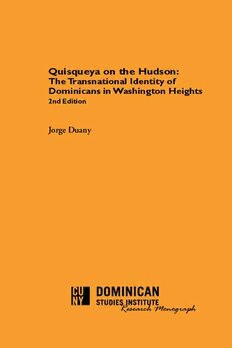Table Of ContentQuisqueya on the Hudson:
The Transnational Identity of
Dominicans in Washington Heights
2nd Edition
Jorge Duany
Research Monograph
Quisqueya on the Hudson:
The Transnational Identity of
Dominicans in Washington Heights
2nd Edition
Jorge Duany
Research Monograph
CUNY Dominican Studies Institute
Dominican Research Monograph Series
Copyright © 2008 CUNY Dominican Studies Institute
Dominican Research Monograph Series, a series of publications of the
CUNY Dominican Studies Institute, seeks to disseminate knowledge
on the Dominican experience in the United States, the Dominican
Republic, and elsewhere. Generally, the texts published in the series
will have been generated by research projects sponsored by the CUNY
Dominican Studies Institute.
Publications Coordinator
Pablo Rodríguez
Credits: This publication had been made possible in part by the
Honorable Councilmember Miguel Martínez, whose generous support
we hereby acknowledge.
The CUNY Dominican Studies Institute at City College is an organized
research unit of the City University of New York approved by the
Board of Trustees of the University February 22, 1994. The Institute’s
primary mission is the production and dissemination of knowledge on
the Dominican experience. City College, Hostos Community College,
and the central administration of CUNY, with the support of the
Dominican Community in New York, have led the effort that created
the CUNY Dominican Studies Institute.
For information on the series or on the overall research agenda of the
Institute, you may visit www.ccny.cuny.edu/dsi or reach the Institute
directly at:
CUNY Dominican Studies Institute
The City College of New York
160 Convent Avenue NA 4/107
New York, NY 10031
Tel.: 212.650.7496
Fax: 212.650.7489
[email protected]
www.ccny.cuny.edu/dsi
Foreword
Originally published by the CUNY Dominican Studies Institute
(CUNY DSI) in 1994, Jorge Duany’s ethnographic study entitled
Quisqueya on the Hudson: The Transnational Identity of Dominicans
in Washington Heights has been a seminal text in the study of the
Dominican community in the United States. Duany documented
distinctive characteristics of the Dominican community in the Unit-
ed States by closely examining the experiences of Dominicans on a
single square block in the celebrated Dominican neighborhood of
Washington Heights. The profound attachment that Dominicans in
New York have toward their ancestral homeland is aptly emphasized
by Duany. According to the author, the immense pride associated
with Dominicanidad is expressed by Dominicans in the diaspora in
a variety of ways, such as popular culture, national symbols, language
and food. This study by Jorge Duany was CUNY DSI’s first publica-
tion and set a lofty standard for the quality of work that would be
published by CUNY DSI. We at the Institute would like to thank
Jorge both for updating his wonderful text in this second edition and
for his incisive and prescient analysis of the Dominican community
in Washington Heights.
Abrazos,
Dr. Ramona Hernández
Director, CUNY Dominican Studies Institute
Professor of Sociology, The City College of New York
Dr. Jorge Duany is Professor of Anthropology and Chair of
the Department of Sociology and Anthropology at the University
of Puerto Rico, Río Piedras. During the spring semester of 2007,
he was the Bacardí Family Eminent Scholar in Latin American
Studies at the University of Florida in Gainesville. He previously
served as Director of the journal Revista de Ciencias Sociales, as
Visiting Professor of Anthropology and American Studies at the
University of Michigan, and as Assistant Director of the Center
for Latin American Studies at the University of Florida. He has
also been a Research Fellow at the Smithsonian Institution in
Washington, D.C., and at the Population Studies Center at the
University of Pennsylvania. He earned his Ph.D. in Latin American
Studies, with a concentration in anthropology, at the University of
California, Berkeley. He also holds an M.A. in Social Sciences from
the University of Chicago and a B.A. in Psychology from Columbia
University. He has published extensively on Caribbean migration,
ethnicity, race, nationalism, and transnationalism in academic
journals and professional books in the Caribbean, North and South
America, Europe, and Asia. His most recent book is titled The
Puerto Rican Nation on the Move: Identities on the Island and in the
United States (2002). He is the coauthor of Puerto Ricans in Orlando
and Central Florida (2006), Cubans in Puerto Rico: Ethnic Economy
and Cultural Identity (1997), and El Barrio Gandul: Economía
subterránea y migración indocumentada en Puerto Rico (1995).
Table of Contents
Preface to the Second Edition 1
Abstract 23
Introduction 24
Literature Review 27
Hypothesis 31
Method 31
The Research Site 36
Results 42
Discussion 57
Conclusion 6 0
References 63
Acknowledgements
The research reported in this paper was sponsored by the Dominican
Studies Institute of the City University of New York (CUNY). I gratefully
acknowledge the support of the Institute’s former Director, Dr. Silvio
Torres-Saillant, and his assistant, Mrs. Doris Oviedo. Dr. Ramona
Hernández the Institute’s current director, endorsed the project from the
beginning. Thanks are also due to my research assistants: my wife, Diana
Johnson, Manuel Méndez, Ana del Carmen García, María Fernández,
Marino Cabrera, and Lovell Quiroz. My sister, Lourdes Duany, gave
generously of her computer expertise. Mrs. Ana García Reyes, then
Director of the Student Support Services Program at City College, and
her assistant Mrs. Yvette Clemente provided administrative help during
my stay in New York. Ana Yolanda Ramos, now a professor at Rutgers
University, and Arlene Dávila, now a professor at New York University,
offered valuable comments on an earlier draft of this paper. Several faculty
members and students affiliated with the Dominican Studies Institute
contributed useful feedback on the manuscript: Luis Alvarez-López,
Marino Cabrera, Ana del Carmen García, Ana García Reyes, Ramona
Hernández, Nancy López, Anthony Stevens-Acevedo, and Silvio Torres-
Saillant. Finally, the Academic Research Center at the University of the
Sacred Heart in Puerto Rico facilitated the time to write this essay during
the fall of 1993.

